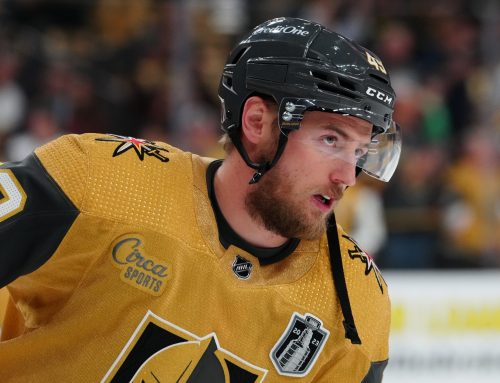Every so often we turn our attentions to some of the stat categories on the site, include a little primer on what they are and then see how we can use them to give some context to what is happening with certain players. We featured Evgeni Malkin last season in our review of IPP. Today it’s Jordan Kyrou.
IPP or Individual Point Percentage is a measure of how often a player receives points on a goal that is scored when they are on the ice. It can more colloquially be referred to as point participation as well. So if five goals are scored when a player is on the ice and they get the goal, or an assist on four of them their IPP would be 80 percent. The stat alone is interesting, but it really gets to be helpful when we have something to compare it to. For instance, we know that forwards tend to have a higher IPP than defensemen. This makes sense as forwards tend to be in position to score more often. We also know that elite forwards tend to have a higher IPP than bottom six forwards, with your elite players reaching potentially 75 to 85 percent. What is most helpful though is comparing a player's current sample size to a recent, larger sample size. For example, Alex Ovechkin's current IPP is 76.9 percent. Ovechkin is an elite forward and that is certainly within the range of other elite forwards so we might not think anything of it. However, there is only one season where Ovechkin participated on more than 70 percent of the goals scored when he was on the ice, and over his last four seasons he has been closer to 63 percent. In this case the inflated IPP means that either something has changed in his game/deployment, or he is getting in on more points that we should expect, and his IPP (and therefore his point pace) will likely drop somewhat.
On Frozen Tools there are a number of places where you can find IPP. For individual players it is listed under the Advanced Tab, and it is included in a number of reports. For our purposes today we are going to focus on the IPP report, because well, we are talking about IPP.
For starters let's take a look at our top participators to date (all data in this article pulled Jan 6, prior to any games played that day).
| Name | Team | GP | PTS | IPP |
| JACK HUGHES | N.J | 17 | 17 | 89.5 |
| JORDAN KYROU | STL | 30 | 33 | 89.2 |
| BRAD MARCHAND | BOS | 24 | 30 | 85.7 |
| PIUS SUTER | DET | 34 | 18 | 85.7 |
| JONATHAN HUBERDEAU | FLA | 33 | 42 | 84 |
Since IPP is a percent, it covers all players and point totals, so those who were on the ice for one goal and got a point will have an IPP of 100. Given that I put in a points cutoff of 15 so we are looking only at players who have a reasonable number of opportunities.
Leading our list here is Jack Hughes. He also has the smallest sample, both in terms of points, and games played, so is likely the most variable. This list also gives us an opportunity to highlight a couple of other features of IPP. IPP really helps to highlight who the play is running through on the ice. Elite players – superstars – tend to have high IPPs and we can see that here with Brad Marchand, and Jonathan Huberdeau. Your Connor McDavids and Leon Draisaitls typically end up here as well. The elite of the elite. And that makes sense, anyone who watches and Edmonton game quickly realizes goals come through McDavid or Draisaitl.
Sometimes though we see other players (looking at your Pius Suter) who end up with high IPPs. With only 18 points, it is hard to argue that Suter is elite. The high IPP could be a function of luck and be very unrepeatable, could be a function of a role on a power play that pulls up his other numbers, or could be a result of Suter driving play on say a third line. This line doesn't score many goals, but when they do Suter is involved because he is the best player on the line. In Suter's case it is likely option A. We don't have a huge history here, but in a 55-game sample last season his IPP was down around 55 percent. Granted a lot of that context was different in Chicago, but that is the data we have to work with.
That leaves us with the player I really wanted to talk about in Jordan Kyrou. Kyrou's previous high point pace was 52, and he is now on pace for 90. He is seeing increased time on ice both in total and on the power play. This is all good, but the reason he is on our list is an almost 90 percent IPP. McDavid himself only has one season with a 90 percent IPP, so that is clearly a very difficult IPP to deserve. Kyrou likely isn't the next McDavid, so it shouldn't be a surprise to anyone that we should expect that percentage to drop. What is good to see is that unlike Suter, Kyrou has a history of hitting 75 percent multiple other times in his career. They are pretty small sample sizes, he did it in his 55-game sample last season. The implication is that Kyrou has been involved in play regardless of where he has slotted in in the lineup, and usually that means he is not lucking into points with good linemates, or the best player on a fourth line who can't hang with the big guns – it means he might actually be good.
In short, I'm loving the Robert Thomas, Kyrou, Vladimir Tarasenko line for all involved, and I'm excited about the Kyrou breakout that has been coming now for a couple of years.
Another good use for IPP is to review the context specific IPP information. The IPP report breaks down a player’s IPP to various strength states – even strength, power play, and shorthanded. This is particularly helpful when we are looking at players who are not meeting our expectations (but can certainly highlight other players as well).
Let's take a quick look at David Pastrnak. Pasta is currently on a 62-point pace – a far cry from his 100 plus point paces a few seasons ago. Now with a 50-point drop there are a lot of compounding factors (his personal shooting percentage, and his secondary assist rate to name just two), but one number that stands out is his six power-play points to date. That equates to a .21 power-play points per game vs his .54 and .5 power-play points per game in his 100-point seasons. Now again there can be a lot of causes for a drop in power-play production, but his power-play IPP is currently 42.9 percent rather than the 75-80 percent of the last three seasons. That means goals are being scored on the power play and he is just not getting in on them. Now we would have to do a slightly deeper dive to really be sure of what is happening, but it seems a pretty reasonable bet that his PPIPP is unsustainably low. If we assume he gets in on even just a few more of those points going forward he very quickly rises to something like a 75-point pace even with no other bounces going his way.
To that end here are the biggest changes between last season. Some of them (Tomas Hertl) had unsustainable PPIPPs last season, but others like Nikolaj Ehlers, and Mark Stone clearly deserve better.
| Name | Team | GP | PPP | 20-21 PPIPP | 21-22 PPIPP | |
| TOMAS HERTL | S.J | 34 | 5 | 55.6 | 100 | -44.4 |
| NIKOLAJ EHLERS | WPG | 32 | 3 | 42.9 | 86.7 | -43.8 |
| MARK STONE | VGK | 19 | 3 | 37.5 | 81 | -43.5 |
| TOM WILSON | WSH | 30 | 3 | 30 | 72.7 | -42.7 |
| ZACH HYMAN | EDM | 31 | 5 | 33.3 | 71.4 | -38.1 |
| CAM ATKINSON | PHI | 33 | 2 | 33.3 | 69.2 | -35.9 |
| DAVID PASTRNAK | BOS | 29 | 6 | 42.9 | 77.8 | -34.9 |
| ANDRE BURAKOVSKY | COL | 27 | 6 | 42.9 | 77.8 | -34.9 |
| FILIP FORSBERG | NSH | 25 | 6 | 42.9 | 76.5 | -33.6 |
That is all for this week
Do your part to support organizations working to make hockey for everyone.






 UTA
UTA ANA
ANA MIN
MIN CAR
CAR MTL
MTL NYI
NYI VGK
VGK DET
DET
